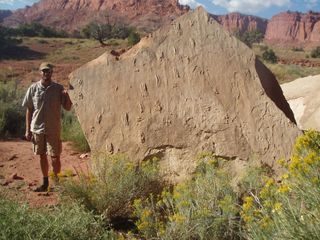Earth's Worst Mass Extinction Preserved Ancient Footprints

Earth's worst mass extinction may have created ideal conditions for preserving the ancient footprints of giant reptiles on the muddy ocean floor, according to a new study.
Researchers found a spike in fossilized tracks of tetrapods (these early four-limbed vertebrates include amphibians, reptiles, birds and mammals) during the early Triassic period, roughly 250 million years ago. This increase may be the result of a mass extinction at the end of the Permian period that wiped out worms and other tiny creatures that typically churn up ocean sediments, leaving behind sticky seafloor conditions that preserved the wading and swimming habits of ancient giant reptiles, the scientists said.
The researchers captured a "Goldilocks" window when they could see this behavior simply because they had "this magical time after this mass extinction," said study co-author Mary Droser, a professor of geology at the University of California, Riverside. [See photos of the ancient reptiles' Triassic tracks]
The start of the Triassic period was a desolate time in Earth's history. Something — a bout of volcanic eruptions, climate change or even an asteroid impact — triggered the extinction of more than 90 percent of Earth's marine species. However, it allowed giant reptiles, such as the dolphin-shaped ichthyosaurs and the long-necked plesiosaurs, to flourish well before the evolution of dinosaurs.
Most of these reptiles preyed on fish and ancient squid. When they walked through the water, their claws pushed against the seafloor, and their bodies trailed through the muddy bottom, leaving noticeable swim tracks. But preserving such tracks for hundreds of millions of years isn't easy, since footprints in sand typically dissolve quickly.
Scientists were surprised to find a large number of fossilized swim tracks from the early Triassic. They found only a few well-preserved swim tracks from other epochs, like the Permian (before the Triassic) and the Jurassic (after the Triassic), but the team counted roughly 40 from the early Triassic. Although it's easy to assume that this is because there were more reptiles living in the early Triassic than during the other periods, the researchers speculated that the mass extinction at the end of the Permian period actually created conditions ripe for preserving fossil tracks.
After the extinction, most animals living in the soil had died, so they couldn’t mix the soil up quite as much. Typically, "there are all sorts of things that keep that sediment mixed," Droser said. "But if you take them away, then the mud becomes sticky and hard." This means that a footprint, or the slithering track of a belly against the ocean floor, for example, won't disappear as quickly.
Sign up for the Live Science daily newsletter now
Get the world’s most fascinating discoveries delivered straight to your inbox.
Tracy Thomson, a University of California, Riverside graduate student working with Droser, spent two summers in Utah uncovering the rare swim tracks. Now a barren desert, the coastline used to run through Glen Canyon and Capitol Reef National Park. It was there that the reptiles would stray by the bays and lagoons before wading a foot or two (0.3 to 0.6 meters) in the water to hunt.
Before now, no one had noticed this spike, for a number of reasons, Droser said. For one, swim tracks are relatively new, scientifically speaking: It was only recently that researchers discovered that these fossils are made by reptiles underwater, and the key is that these tracks tend to meander, and even disappear, for short distances before reappearing, Droser explained.
The reptiles "are meaning to stay on the substrate, to stay on the ground," Droser said. But the water's current lifts them up, and "they get carried a little bit until they find their footing again," she said. As such, the tracks rarely move in a straight line, Droser added.
By providing a window into this unique time, Droser and Thomson hope to shed light on Earth's largest mass extinction, which is sometimes called the Great Dying.
The study was published online Feb. 5 in the journal Geology.
Follow Shannon Hall on Twitter @ShannonWHall. Follow Live Science @livescience, Facebook & Google+. Original article on Live Science.
Most Popular


